Advancing Research on Urban Ecological Corridors in the Context of Carbon Neutrality: Insights from Bibliometric and Systematic Reviews
Abstract
1. Introduction
1.1. Urban Ecological Corridors: Definition and Ecological Functions
1.2. Urban Planning Integration and Urbanization Challenges
1.3. Carbon Neutrality Context and Research Gaps
1.4. Research Objectives and Methodology
2. Methods
2.1. Data Collection and Search Strategy
2.2. Article Inclusion Criteria
2.3. Software Parameters
3. Bibliometric Analysis of Urban Ecological Corridor Research Under the Global Carbon Neutrality Context
3.1. Annual Publication Output and Trends
3.2. Analysis of National Cooperation Relationships
3.3. Analysis of Author Cooperation Relationships
3.4. Journal and Institutional Analysis
4. Research Hotspots and Trend Evolution Discussion
4.1. Research Hotspot Identification
4.2. Knowledge Structure and Evolution Patterns
4.3. Emerging Research Frontiers
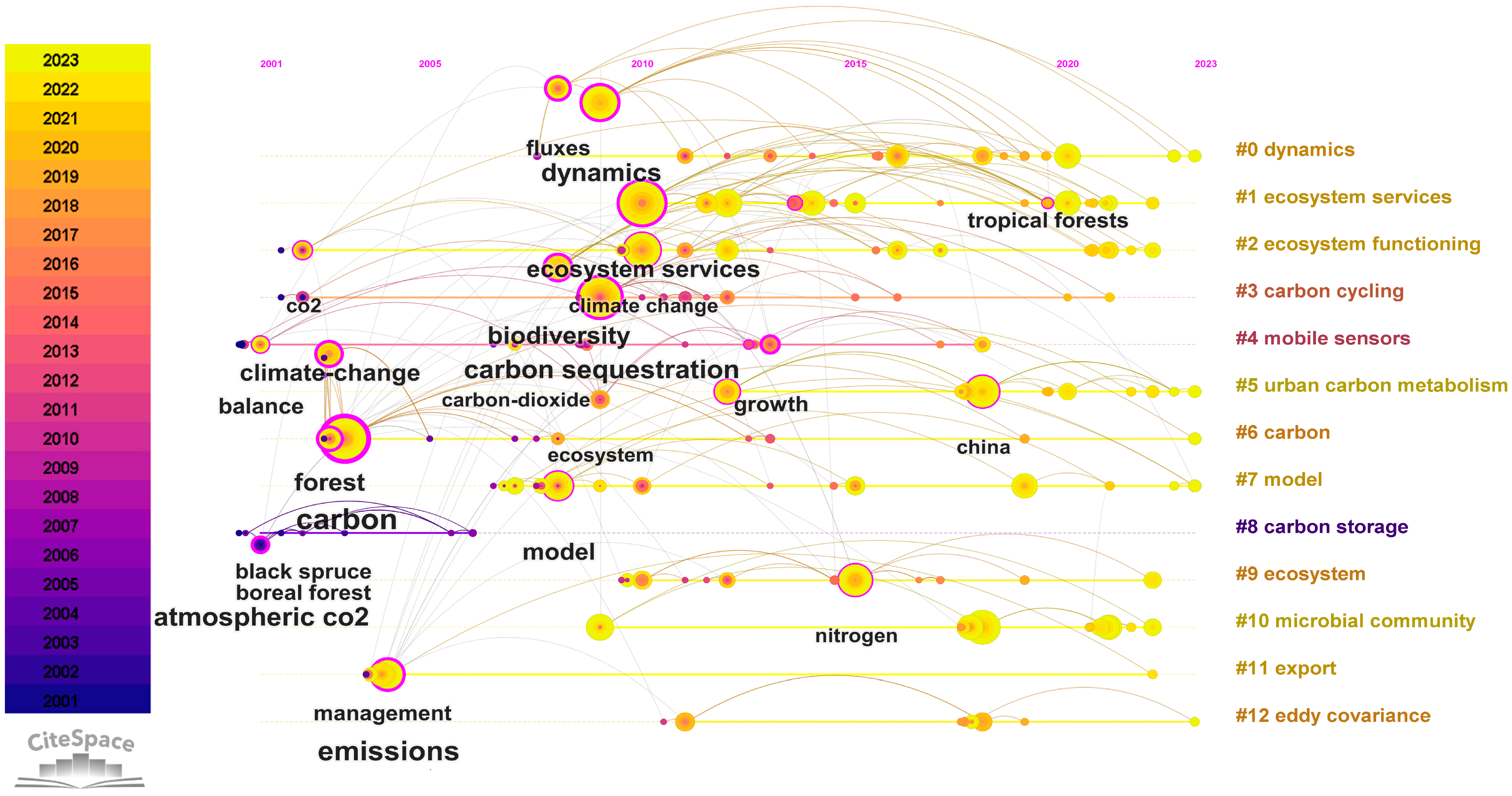
4.4. Research Gaps and Future Directions
5. Co-Citation Analysis Discussion
5.1. Co-Citation Analysis of Authors
5.2. Co-Citation Analysis of References
6. Conclusions
Supplementary Materials
Author Contributions
Funding
Institutional Review Board Statement
Informed Consent Statement
Data Availability Statement
Conflicts of Interest
References
- Bahrami, B.; Hildebrandt, A.; Thober, S.; Rebmann, C.; Fischer, R.; Samaniego, L.; Rakovec, O.; Kumar, R. Developing a parsimonious canopy model (PCM v1.0) to predict forest gross primary productivity and leaf area index of deciduous broad-leaved forest. Geosci. Model Dev. 2022, 15, 6957–6984. [Google Scholar] [CrossRef]
- Flechard, C.R.; Ibrom, A.; Skiba, M.; Vries, W.; Van Oijen, M.; Cameron, D.R.; Dise, N.B.; Korhonen, J.; Buchmann, N.; Legout, A.; et al. Carbon–nitrogen interactions in European forests and semi-natural vegetation—Part 1: Fluxes and budgets of carbon, nitrogen and greenhouse gases from ecosystem monitoring and modelling. Biogeosciences 2020, 17, 1583–1620. [Google Scholar] [CrossRef]
- Lü, Y.; Ma, Z.; Zhao, Z.; Sun, F.; Fu, B. Effects of Land Use Change on Soil Carbon Storage and Water Consumption in an Oasis-Desert Ecotone. Environ. Manag. 2014, 53, 1066–1076. [Google Scholar] [CrossRef]
- Chang, S.-C.; Saitoh, T.; Shibata, H.; Suzuki, S. Recent advances in the understanding of ecosystem processes at eddy covariance CO2 flux sites in East Asian forest ecosystems: A review. J. Agric. Meteorol. 2021, 77, 52–65. [Google Scholar] [CrossRef]
- Zhang, C.; Liu, J.; Zhang, L. Generation and discrimination of three derived concepts based on the application of the urban ecological corridor concept. Chin. Landsc. Archit. 2021, 37, 109–114. [Google Scholar] [CrossRef]
- Li, X.; Hu, S.; Jiang, L.; Han, B.; Li, J.; Wei, X. Bibliometric Analysis of the Research (2000–2020) on Land-Use Carbon Emissions Based on CiteSpace. Land 2023, 12, 165. [Google Scholar] [CrossRef]
- Gopalakrishnan, V.; Grubb, G.F.; Bakshi, B.R. Biosolids management with net-zero CO2 emissions: A techno-ecological synergy design. Clean Technol. Environ. Policy 2017, 19, 2099–2111. [Google Scholar] [CrossRef]
- Huang, J.; Hu, Y.; Zheng, F. Research on recognition and protection of ecological security patterns based on circuit theory: A case study of Jinan City. Environ. Sci. Pollut. Res. 2020, 27, 12414–12427. [Google Scholar] [CrossRef]
- He, J.; Pan, Y.; Liu, D. Analysis of the wetland ecological pattern in Wuhan City from the perspective of ecological network. Acta Ecol. Sin. 2020, 40, 3590–3601. [Google Scholar]
- Chen, Q.; Li, M.; Wang, X.; Faisal, M.Q.; Wang, P.; Yang, J.; Wang, M.; Yang, W. Identification of potential ecological corridors for Marco Polo sheep in Taxkorgan Wildlife Nature Reserve, Xinjiang, China. Biodivers. Sci. 2019, 27, 186–199. [Google Scholar] [CrossRef]
- Guo, X.; Zhang, X.; Du, S.; Li, C.; Siu, Y.L.; Rong, Y.; Yang, H. The impact of onshore wind power projects on ecological corridors and landscape connectivity in Shanxi, China. J. Clean. Prod. 2020, 254, 120075. [Google Scholar] [CrossRef]
- Wang, Q.; Fu, M.; Wei, L.; Han, Y.; Shi, N.; Li, J.; Quan, Z. Urban ecological security pattern based on source-sink landscape theory and MCR model: A case study of Ningguo City, Anhui Province. Acta Sci. Circumst. 2016, 36, 4546–4554. [Google Scholar]
- Wang, H.; Li, H.; Xie, M.; Xu, M.; Li, S.; Bai, Z. Construction of ecological security pattern for systematic restoration of industrial and mining land in resource-based cities. J. Nat. Resour. 2020, 35, 162–173. [Google Scholar] [CrossRef]
- Yu, H.; Gu, X.; Liu, G.; Fan, X.; Zhao, Q.; Zhang, Q. Construction of Regional Ecological Security Patterns Based on Multi-Criteria Decision Making and Circuit Theory. Remote Sens. 2022, 14, 527. [Google Scholar] [CrossRef]
- Shan, N.; Zhou, K.X.; Pan, Y.; Tang, F. Research advances in design methods of biodiversity conservation corridors. Acta Ecol. Sin. 2019, 39, 411–420. [Google Scholar] [CrossRef]
- Yu, H.; Xiao, H.; Gu, X. Impact of urban environmental matrices on bird diversity: Mediating effects and ecological thresholds. Appl. Geogr. 2025, 174, 103476. [Google Scholar] [CrossRef]
- Gou, M.; Li, L.; Ouyang, S.; Shu, C.; Xiao, W.; Wang, N.; Hu, J.; Liu, C. Integrating ecosystem service trade-offs and rocky desertification into ecological security pattern construction in the Daning river basin of southwest China. Ecol. Indic. 2022, 138, 108845. [Google Scholar] [CrossRef]
- Gray, A.N.; Whittier, T.R. Carbon stocks and changes on Pacific Northwest national forests and the role of disturbance, management, and growth. For. Ecol. Manag. 2014, 328, 167–178. [Google Scholar] [CrossRef]
- Wang, Y.; Qu, Z.; Zhong, Q.; Zhang, Q.; Zhang, L.; Zhang, R.; Yi, Y.; Zhang, G.; Li, X.; Liu, J. Delimitation of ecological corridors in a highly urbanizing region based on circuit theory and MSPA. Ecol. Indic. 2022, 142, 109258. [Google Scholar] [CrossRef]
- Cockburn, J.M.H.; Scott, A.; Villard, P.V. Evaluating Water and Carbon Retention in a Low-Order, Designed River Corridor. Land 2022, 11, 2256. [Google Scholar] [CrossRef]
- Su, L.; Yu, W.; Zhou, Z. Global Trends of Carbon Finance: A Bibliometric Analysis. Sustainability 2023, 15, 6784. [Google Scholar] [CrossRef]
- Feng, S.; Chen, K. The Impact of Forestry Carbon Sink on Land Use Space Based on FLUS Model. Processes 2023, 11, 608. [Google Scholar] [CrossRef]
- Liu, X.; Li, X.; Li, Y.; Zhao, S.; Dai, Z.; Duan, M. Construction and optimization of ecological network in rapidly urbanized area: A case study of Daxing District, Beijing. Acta Ecol. Sin. 2023, 43, 8321–8331. [Google Scholar] [CrossRef]
- Guan, Y.; Bai, J.; Tian, X.; Zhi, L.; Yu, Z. Integrating ecological and socio-economic systems by carbon metabolism in a typical wetland city of China. J. Clean. Prod. 2021, 279, 123342. [Google Scholar] [CrossRef]
- Mao, X.; Wei, X.; Engel, B.; Wei, X.; Zhang, Z.; Tao, Y.; Wang, W. Network-based perspective on water-air interface GHGs flux on a cascade surface-flow constructed wetland in Qinghai-Tibet Plateau, China. Ecol. Eng. 2020, 151, 105862. [Google Scholar] [CrossRef]
- Kangas, J.; Ollikainen, M. A PES scheme promoting forest biodiversity and carbon sequestration. For. Policy Econ. 2022, 136, 102692. [Google Scholar] [CrossRef]
- Prescott, C.E. Sinks for plant surplus carbon explain several ecological phenomena. Plant Soil 2022, 476, 689–698. [Google Scholar] [CrossRef]
- Keenan, T.F.; Davidson, E.A.; Munger, J.W.; Richardson, A.D. Rate my data: Quantifying the value of ecological data for the development of models of the terrestrial carbon cycle. Ecol. Appl. 2013, 23, 273–286. [Google Scholar] [CrossRef]
- Qiu, S.; Yu, Q.; Niu, T.; Fang, M.; Guo, H.; Liu, H.; Li, S.; Zhang, J. Restoration and renewal of ecological spatial network in mining cities for the purpose of enhancing carbon Sinks: The case of Xuzhou, China. Ecol. Indic. 2022, 143, 109313. [Google Scholar] [CrossRef]
- Niemelä, J.; Saarela, S.-R.; Söderman, T.; Kopperoinen, L.; Yli-Pelkonen, V.; Väre, S.; Kotze, D.J. Using the ecosystem services approach for better planning and conservation of urban green spaces: A Finland case study. Biodivers. Conserv. 2010, 19, 3225–3243. [Google Scholar] [CrossRef]
- Li, H.; Zhang, T.; Cao, X.; Yao, L. Active Utilization of Linear Cultural Heritage Based on Regional Ecological Security Pattern along the Straight Road (Zhidao) of the Qin Dynasty in Shaanxi Province, China. Land 2023, 12, 1361. [Google Scholar] [CrossRef]
- Li, L.; Huang, X.; Yang, H. A new framework for identifying ecological conservation and restoration areas to enhance carbon storage. Ecol. Indic. 2023, 154, 110523. [Google Scholar] [CrossRef]
- Roman, M.; Wagner, A. An enormous potential for niche construction through bacterial cross-feeding in a homogeneous environment. PLoS Comput. Biol. 2018, 14, e1006340. [Google Scholar] [CrossRef]
- Rong, T.; Zhang, P.; Zhu, H.; Jiang, L.; Li, Y.; Liu, Z. Spatial correlation evolution and prediction scenario of land use carbon emissions in China. Ecol. Inform. 2022, 71, 101802. [Google Scholar] [CrossRef]
- Liang, X.; Liu, Z.; Zhai, L.; Ji, L.; Feng, Y.; Sang, H. Spatial terrestrial carbon emissions/sequestrations evolution based on ecological network analysis in Beijing-Tianjin-Hebei urban agglomeration. Ecol. Eng. 2023, 189, 106914. [Google Scholar] [CrossRef]
- Liu, J.; Gao, W.; Liu, T.; Dai, L.; Wu, L.; Miao, H.; Yang, C. A Bibliometric Analysis of the Impact of Ecological Restoration on Carbon Sequestration in Ecosystems. Forests 2023, 14, 1442. [Google Scholar] [CrossRef]
- Zhang, G.; Xing, L.; Zhang, L. Research progress on monitoring methods for carbon sequestration in urban green spaces. Garden 2022, 39, 4–9,49. [Google Scholar]
- Zhang, G.; Zhong, Q.; Zhang, L. Research on the construction of carbon sequestration capacity in urban garden greening aimed at carbon neutrality. Landsc. Archit. 2022, 29, 12–16. [Google Scholar] [CrossRef]
- Cai, M.; An, C.; Guy, C. A scientometric analysis and review of biogenic volatile organic compound emissions: Research hotspots, new frontiers, and environmental implications. Renew. Sustain. Energy Rev. 2021, 149, 111317. [Google Scholar] [CrossRef]
- Cao, Y.; Qi, F.; Cui, H. Toward carbon neutrality: A bibliometric analysis of technological innovation and global emission reductions. Environ. Sci. Pollut. Res. 2023, 30, 73989–74005. [Google Scholar] [CrossRef]
- Wang, H.; Li, X.; Xiao, J.; Ma, M.; Tan, J.; Wang, X.; Geng, L. Carbon fluxes across alpine, oasis, and desert ecosystems in northwestern China: The importance of water availability. Sci. Total Environ. 2019, 697, 133978. [Google Scholar] [CrossRef]
- Yuan-Yuan, G.; Ting-Ting, G. Ecological Landscape Design of Qinglong Lake Wetland Park of Yichang Hubei Province from the Perspective of Ecological Town. J. Environ. Prot. Ecol. 2022, 23, 2658–2665. [Google Scholar]
- Cheng, P.; Tang, H.; Lin, F.; Kong, X. Bibliometrics of the nexus between food security and carbon emissions: Hotspots and trends. Environ. Sci. Pollut. Res. 2023, 30, 25981–25998. [Google Scholar] [CrossRef]
- Deng, C.; Ying-Ning, Z.; Hashem, A.; Kuca, K.; Abd Allah, E.F.; Wu, Q.-S. The visualized knowledge map and hot topic analysis of glomalin-related soil proteins in the carbon field based on Citespace. Chem. Biol. Technol. Agric. 2023, 10, 48. [Google Scholar] [CrossRef]
- Li, X.; Tang, J.; Li, W.; Si, Q.; Guo, X.; Niu, L. A Bibliometric Analysis and Visualization of Aviation Carbon Emissions Studies. Sustainability 2023, 15, 4644. [Google Scholar] [CrossRef]
- Geng, Y.; Zhu, R.; Maimaituerxun, M. Bibliometric review of carbon neutrality with CiteSpace: Evolution, trends, and framework. Environ. Sci. Pollut. Res. 2022, 29, 76668–76686. [Google Scholar] [CrossRef]
- Lai, Q.; Ma, J.; He, F.; Zhang, A.; Pei, D.; Wei, G.; Zhu, X. Research Development, Current Hotspots, and Future Directions of Blue Carbon: A Bibliometric Analysis. Water 2022, 14, 1193. [Google Scholar] [CrossRef]
- Huang, L.; Zhou, M.; Lv, J.; Chen, K. Trends in global research in forest carbon sequestration: A bibliometric analysis. J. Clean. Prod. 2020, 252, 119908. [Google Scholar] [CrossRef]
- Yu, H.; Xiao, H.; Gu, X. Integrating species distribution and piecewise linear regression model to identify functional connectivity thresholds to delimit urban ecological corridors. Comput. Environ. Urban Syst. 2024, 113, 102177. [Google Scholar] [CrossRef]
- Blanco, J.; Bellón, B.; Fabricius, C.; de O Roque, F.; Pays, O.; Laurent, F.; Fritz, H.; Renaud, P.C. Interface processes between protected and unprotected areas: A global review and ways forward. Glob. Change Biol. 2020, 26, 1138–1154. [Google Scholar] [CrossRef]
- Yu, H.; Jiang, J.; Gu, X.; Cao, C.; Shen, C. Using dynamic Bayesian belief networks to infer the effects of climate change and human activities on changes in regional ecosystem services. Ecol. Indic. 2025, 170, 113023. [Google Scholar] [CrossRef]
- Yu, H.; Chen, X.; Gu, X.; Yi, Y.; Qiu, H.; Zhang, L. Reimagining Urban Airflow: Functional Connectivity and Key Space Identification in High-Density City Ventilation Networks. Sustain. Cities Soc. 2025, 130, 106635. [Google Scholar] [CrossRef]
- Hui, L.; Wang, H.; Liu, J.; Ye, X.; Han, B.; Xia, Y.; Zhang, L.; Jiao, L. Identifying priority conservation areas based on systematic conservation planning analysis in the Loess Plateau, China. Glob. Ecol. Conserv. 2025, 58, e03495. [Google Scholar] [CrossRef]
- Liang, H.; Li, W.; Zhang, Q.; Zhu, W.; Chen, D.; Liu, J.; Shu, T. Using unmanned aerial vehicle data to assess the three-dimension green quantity of urban green space: A case study in Shanghai, China. Landsc. Urban Plan. 2017, 164, 81–90. [Google Scholar] [CrossRef]
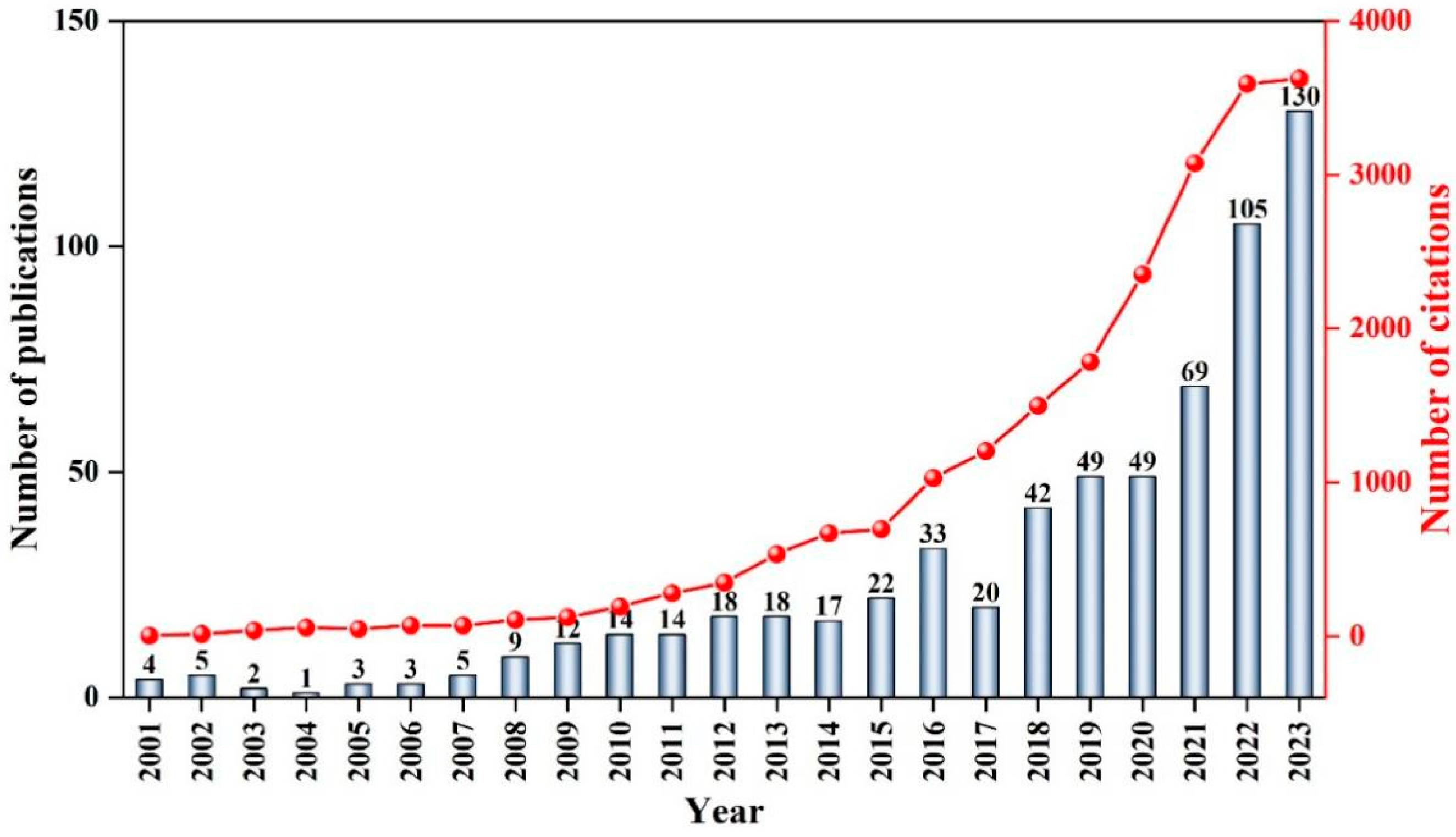
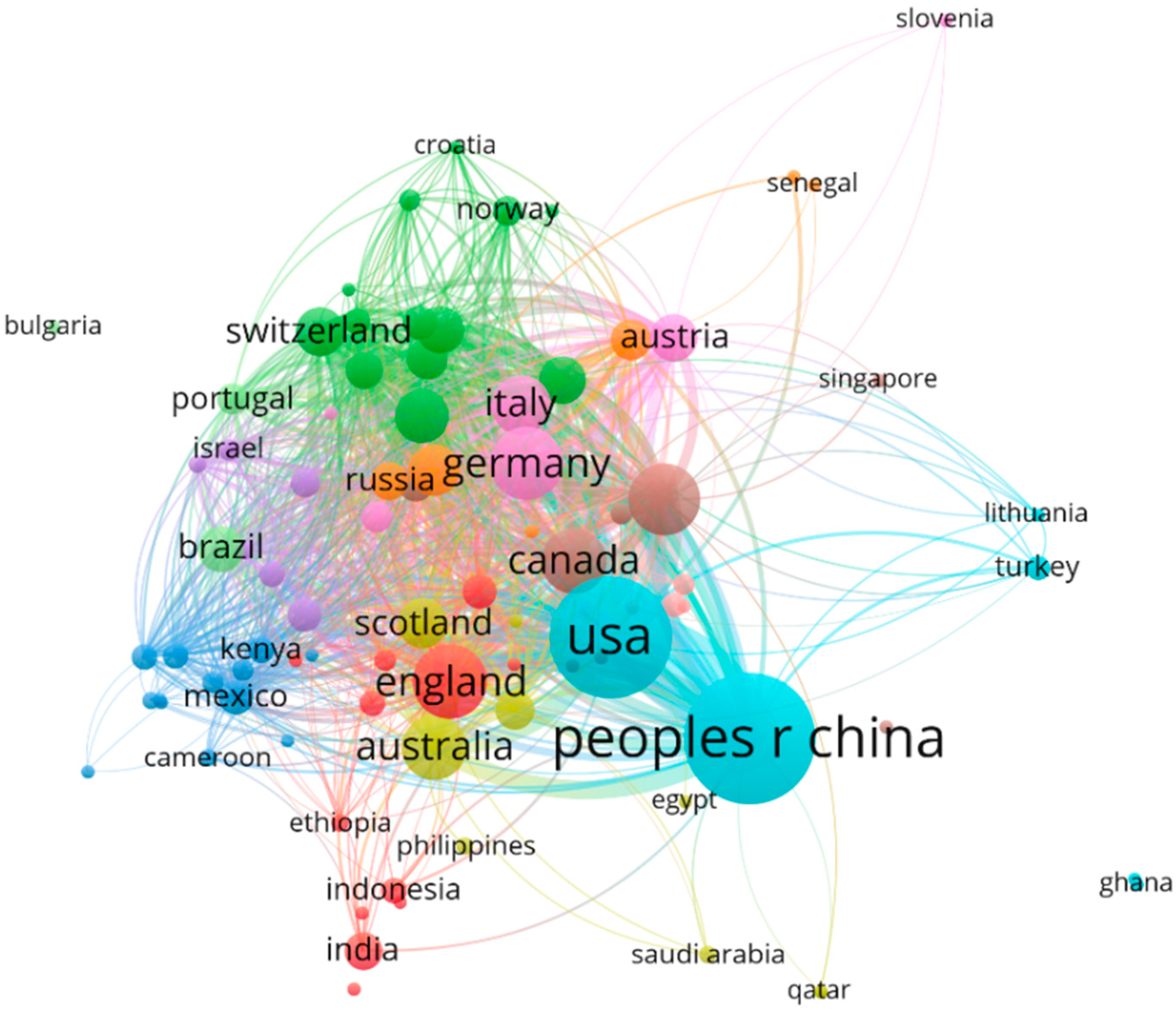
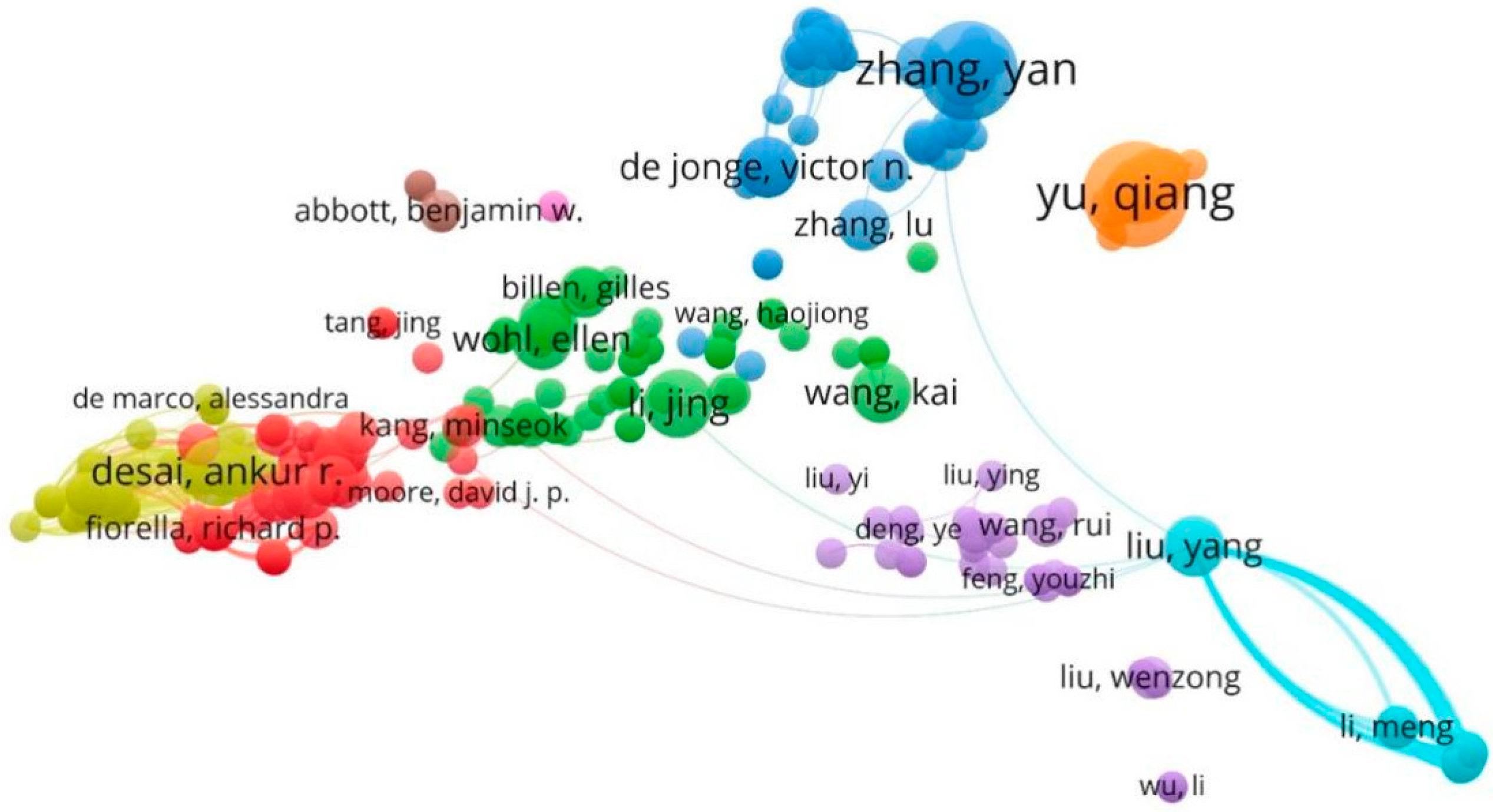

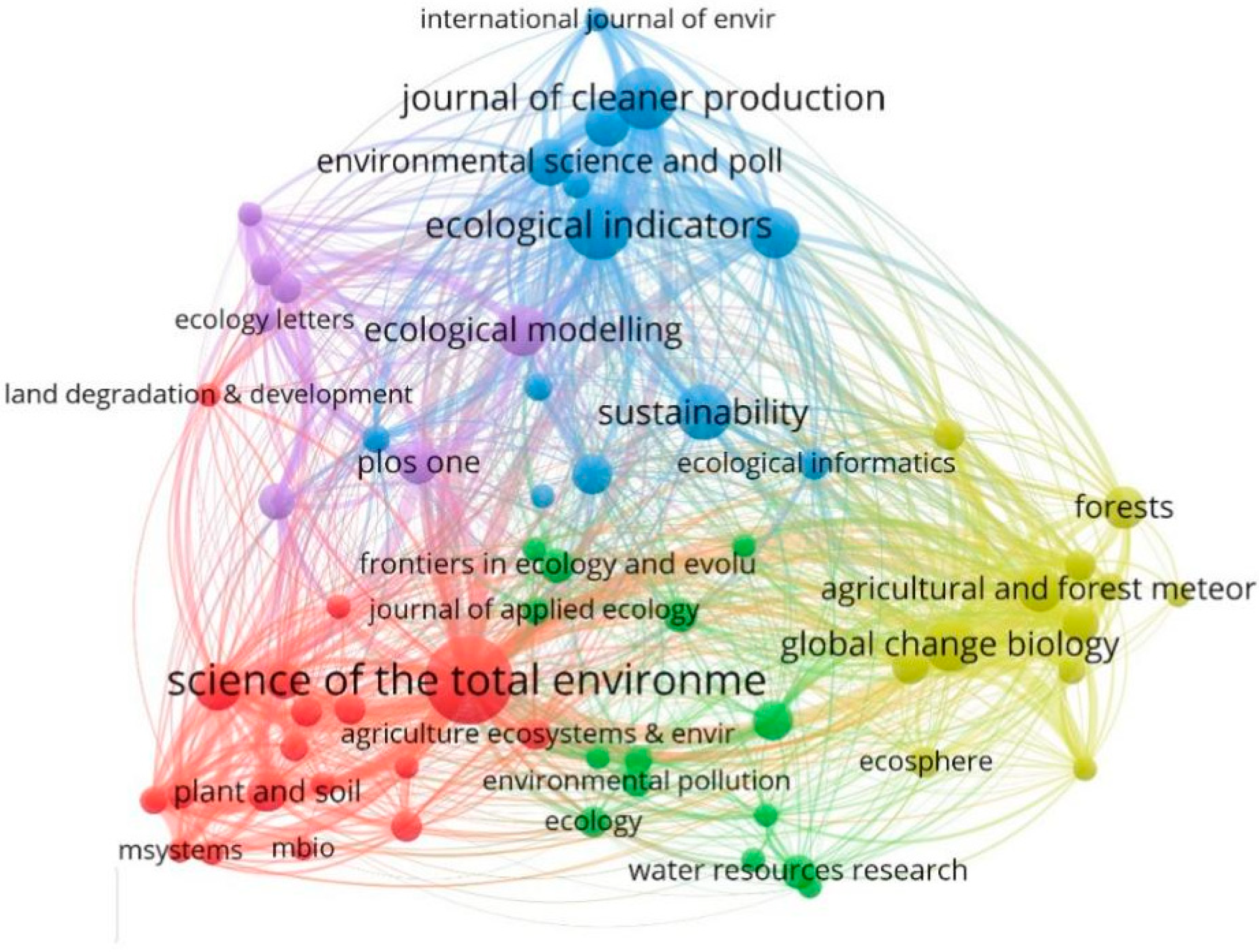
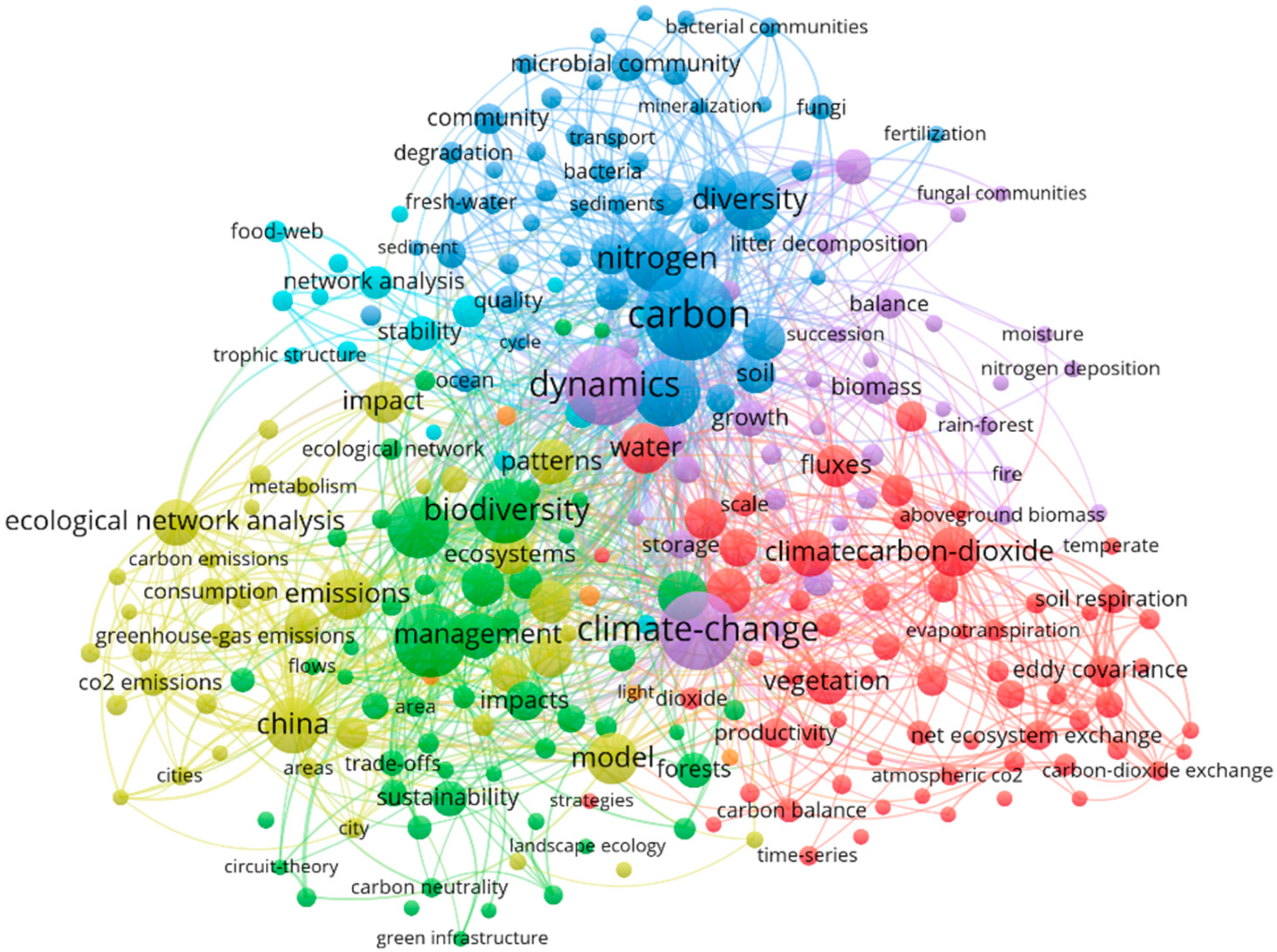
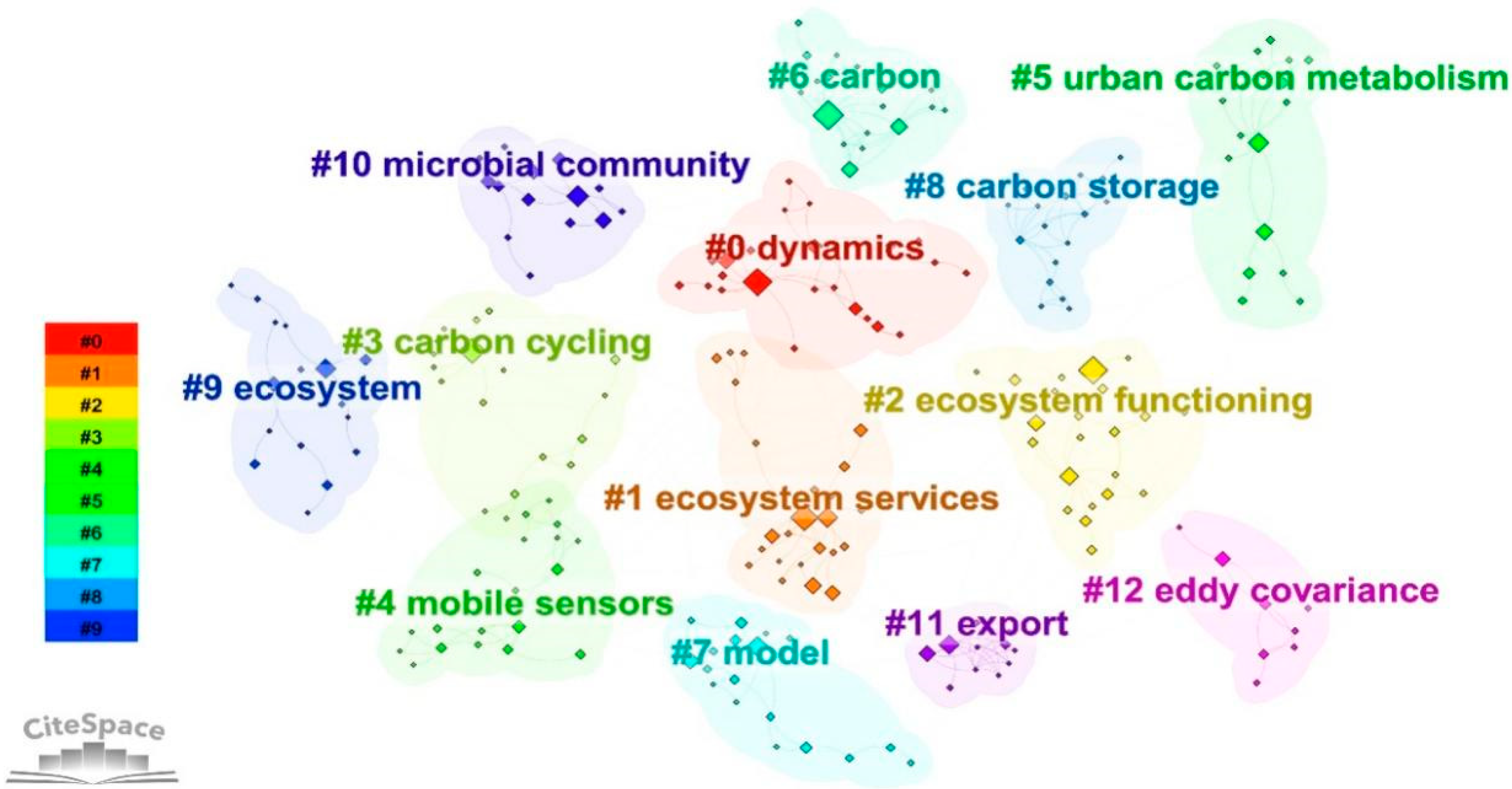
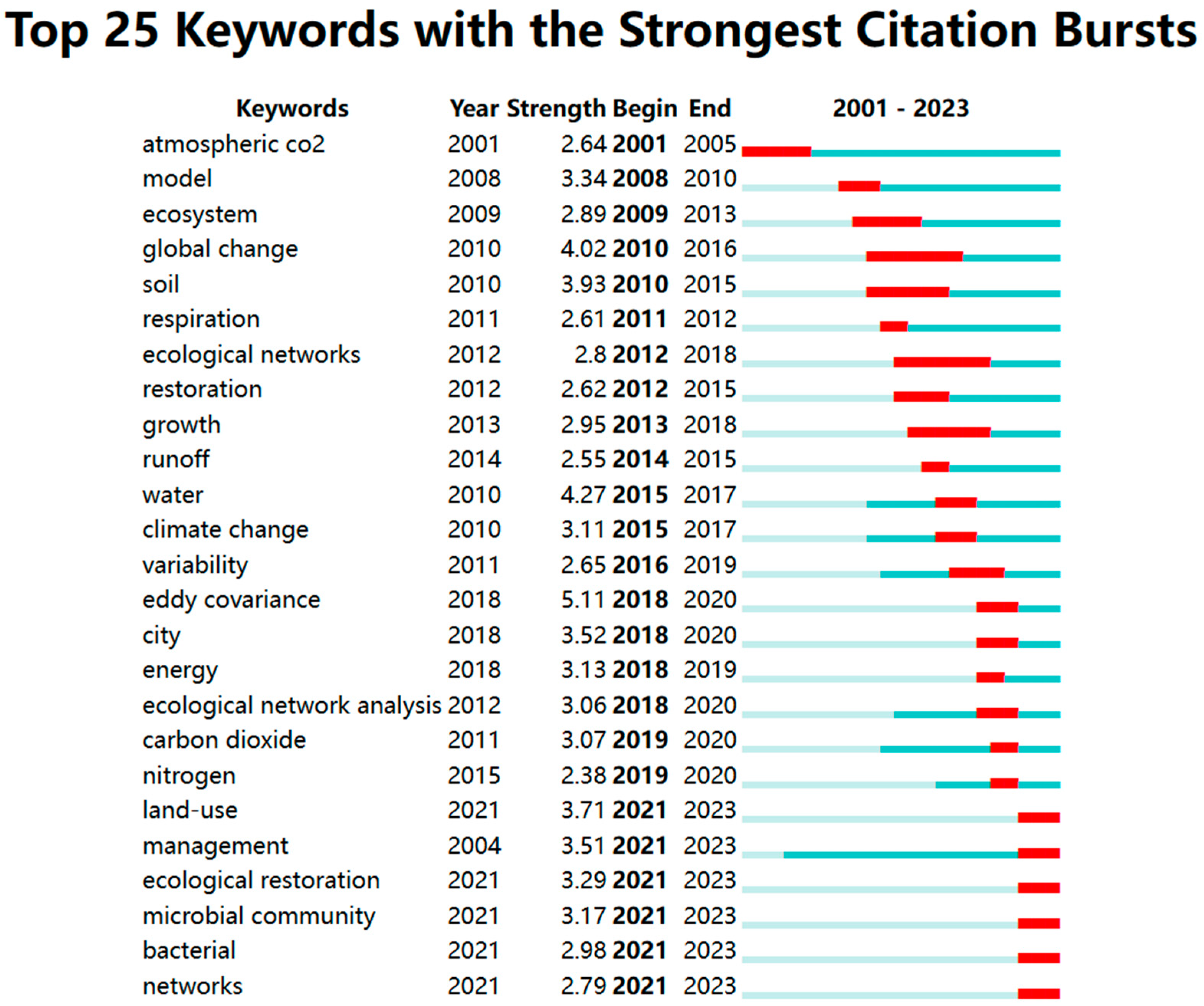
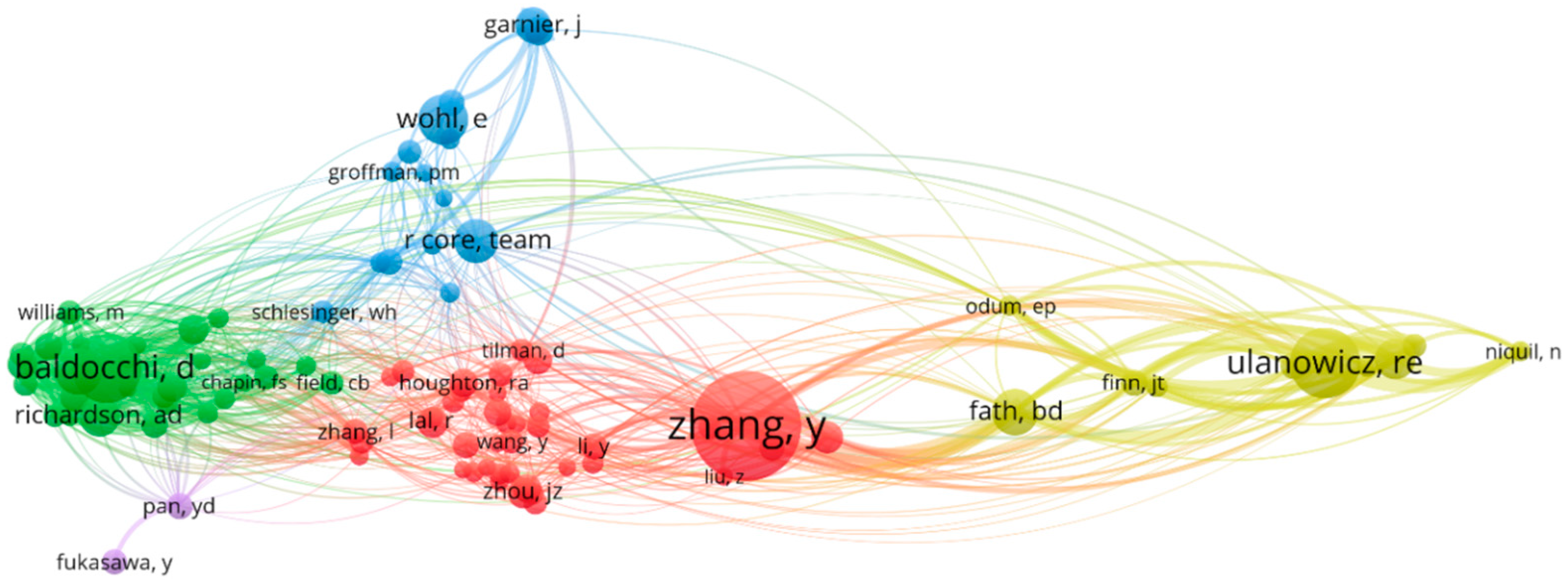
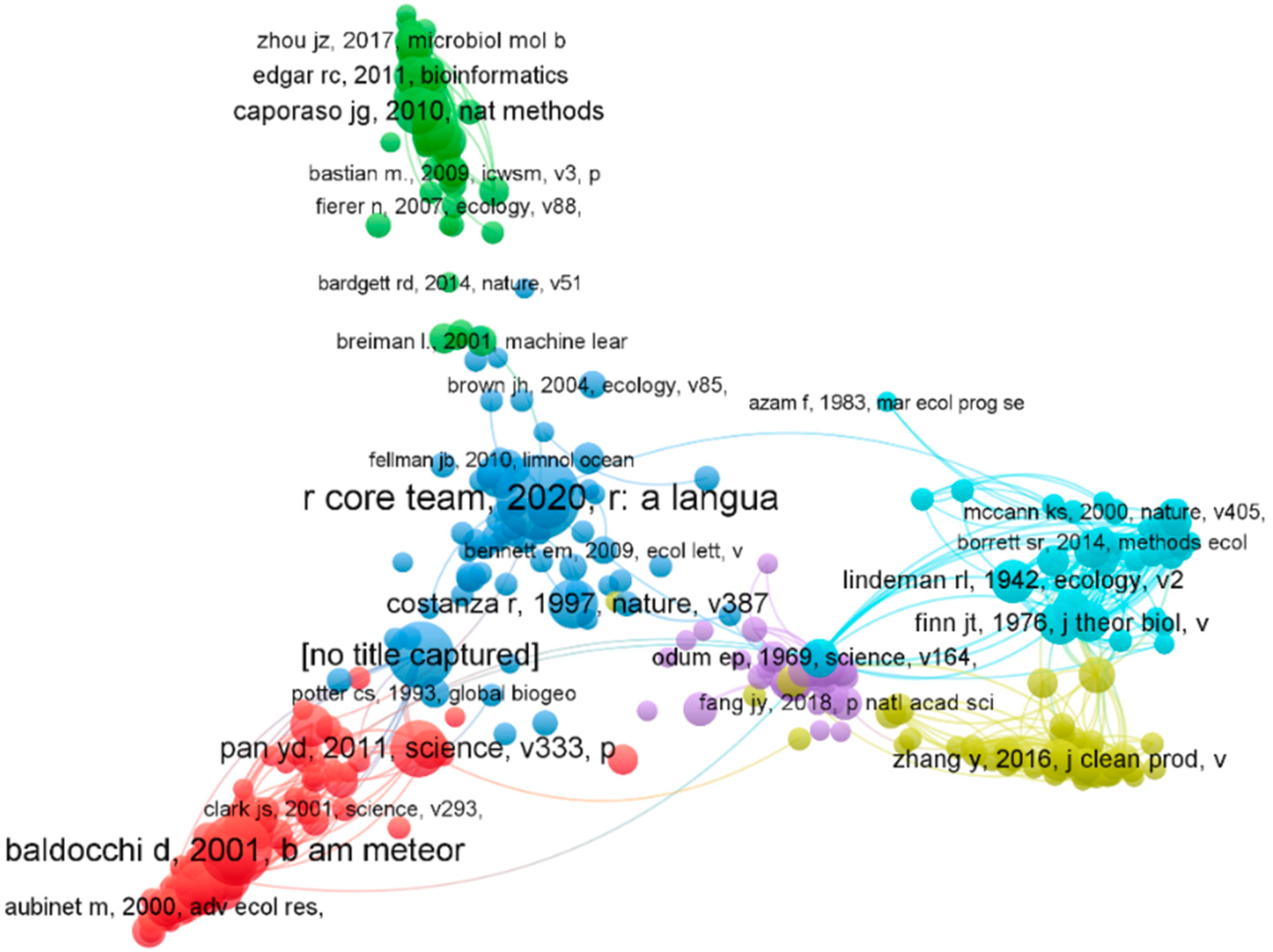
| Content | Web of Science Core Collection | |
|---|---|---|
| Database Information | ||
| Data sources | 1 January 2000–31 December 2023 | 24-year publication period |
| Search date | 2 January 2024 | Data collection completion |
| Languages | English only | Language restriction |
| Document type | Article and review | Peer-reviewed publications |
| Search Strategy | ||
| #1 | 217,996 | TS=(Carbon Neutral OR Carbon Neutrality OR dual carbon OR Carbon sequestration OR carbon stores OR carbon fluxes OR carbon sinks OR Carbon Balance) |
| #2 | 28,158 | TS=(ecological network OR ecological corridor) |
| #3 | 679 | #1 AND #2 |
| Filtering Process | ||
| #4 | 664 | #3 AND Document types: (Article AND Review) |
| #5 | 644 | #4 AND Language: (English) |
| #6 | 644 | Final dataset after manual screening |
| Quality Control | ||
| Manual review | Conducted | Title and abstract screening by two authors |
| Inclusion criteria | Applied | Focus on urban ecological corridors in carbon neutrality context |
| Exclusion criteria | Applied | Non-relevant or superficial mentions removed |
| Final Results | ||
| Total articles | 644 | Ready for bibliometric analysis |
| Export format | Plain text | Compatible with VOSviewer and CiteSpace |
| Data completeness | 100% | Full bibliographic records with citations |
Disclaimer/Publisher’s Note: The statements, opinions and data contained in all publications are solely those of the individual author(s) and contributor(s) and not of MDPI and/or the editor(s). MDPI and/or the editor(s) disclaim responsibility for any injury to people or property resulting from any ideas, methods, instructions or products referred to in the content. |
© 2025 by the authors. Licensee MDPI, Basel, Switzerland. This article is an open access article distributed under the terms and conditions of the Creative Commons Attribution (CC BY) license (https://creativecommons.org/licenses/by/4.0/).
Share and Cite
Li, J.; Zhang, L.; Yi, Y.; Hong, J. Advancing Research on Urban Ecological Corridors in the Context of Carbon Neutrality: Insights from Bibliometric and Systematic Reviews. Atmosphere 2025, 16, 1174. https://doi.org/10.3390/atmos16101174
Li J, Zhang L, Yi Y, Hong J. Advancing Research on Urban Ecological Corridors in the Context of Carbon Neutrality: Insights from Bibliometric and Systematic Reviews. Atmosphere. 2025; 16(10):1174. https://doi.org/10.3390/atmos16101174
Chicago/Turabian StyleLi, Jing, Lang Zhang, Yang Yi, and Jingbo Hong. 2025. "Advancing Research on Urban Ecological Corridors in the Context of Carbon Neutrality: Insights from Bibliometric and Systematic Reviews" Atmosphere 16, no. 10: 1174. https://doi.org/10.3390/atmos16101174
APA StyleLi, J., Zhang, L., Yi, Y., & Hong, J. (2025). Advancing Research on Urban Ecological Corridors in the Context of Carbon Neutrality: Insights from Bibliometric and Systematic Reviews. Atmosphere, 16(10), 1174. https://doi.org/10.3390/atmos16101174







